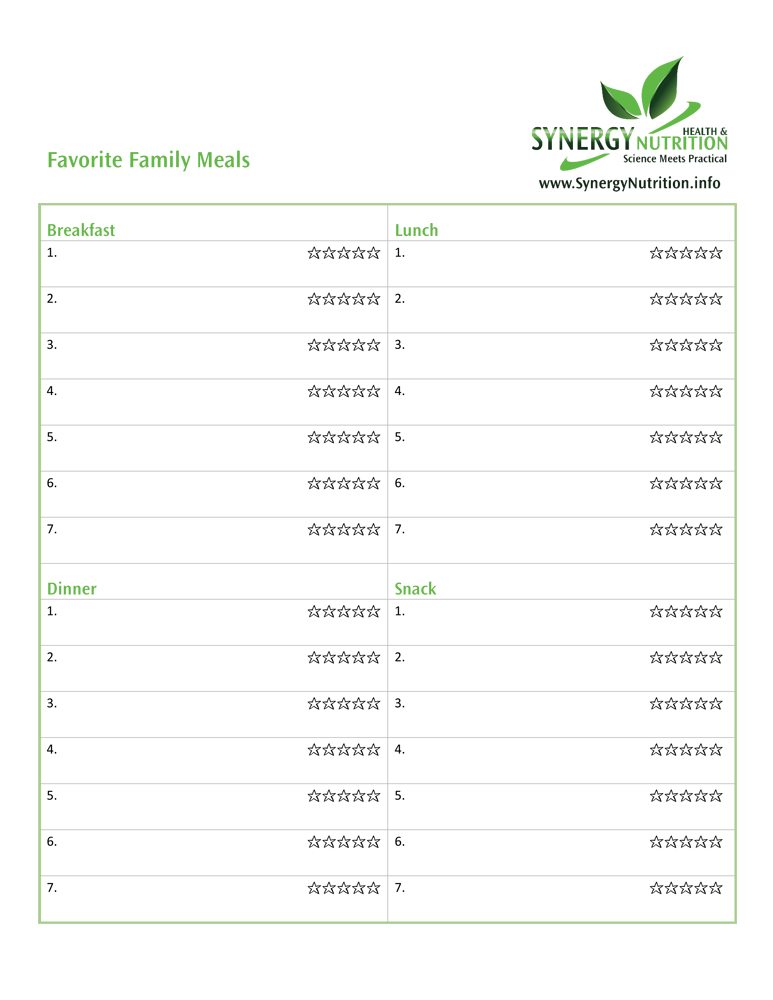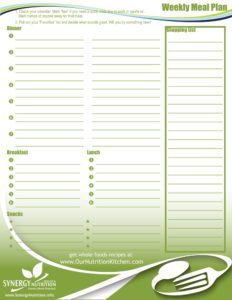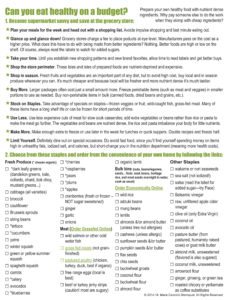Favorite meals to love
What's your planning personality?
To some, the word p-l-a-n is just another 4-letter word to protest and shun. I get that.
To others, planning is a life-saving tool that creates order, avoids miscommunications, and (most importantly) saves time. No more running out for that one thing…
Just like your dietary preferences, you’ll evolve your planning style over time. Choose something intentionally, but don’t fret over it and do change it if you must.
Directions:
1. Decide on a planning system; which works best for you?
- Paper: Paper planner, a binder, or a regular old notepad that you can carry with you
- Electronic: keep track of your meals on Google Calendar or your smartphone (train family members to send a text when they use the last of something)
- Whiteboard: answer “what’s for dinner?” and let family members contribute to ideas / shopping lists by placing a whiteboard in your kitchen.
Most steps in Eating To Restore Balance take about 20 minutes each. Don’t try to do it all at once—consider spending 20-30 minutes several times a week moving through the information and tips. This is your transformation. The investment now will give you a system that saves you hours every future week.
2. Once you’ve evolved your system, pick one, less chaotic day and a time when you’ll be able to complete the entire week’s meal planning (ideally) in one setting. The best routine is a time when you won’t be interrupted. Some people like early mornings, others take a lunch break, yet others wait until late evening when the children are in bed.
Today's steps:
- Make a list of your 14 favorite meals AND
- Take inventory of your freezer, fridge, and pantry AND
- Write down any family events this week (field trips, sports, yoga… who, what day and time?)
1. Make a Master List of 14 favorite & healthy meals
Reviewing from last week, these 14 favorites should:
- incorporate plenty of vegetables
- include foods that were grown and raised as naturally as you can find
- not be obviously sweet (for now, judge by it’s name)
- not include “the whites”: flour, rice, pasta, bread, crackers, cereal, sugars (again, just judge by the name, for now)
Here’s a little secret: Most of us repeat the same 14-21 meals, even families. Sometimes we vary them but they’re not really that different.
The beauty of turning these into a Master List is that you can pull it up each time you sit down to plan. No more wracking your brain thinking “What sounds good???” Glance at your Master List, start slotting things into your plan. Fini. Bada bing, bada boom.
Keep it simple!
Involve your household
Would you like your spouse, children, house-mates… to eat healthy with you?
Invite them!
Tell them you want to get away from cereal or pancakes, PBJ’s… Ask them to list out their 3-4 favorite other breakfasts, 3-4 favorite non-sandwich lunches, 3-4 favorite non-sweet and non-chip snacks, and 3-4 favorite non-pasta dinners. Add the ones that make sense to your Master List of “14 meals your family will love”.
Darken a star for each family member who likes that meal. Or color code them by family member (e.g. Johnnie will be gone Tuesday so let’s have that meal everyone but him loves.)
I keep mine in a binder on a shelf with my cookbooks. Over the years, my “Family Favorites” book has evolved into sections for Breakfast, Lunch, Portable Lunch, Dinner, Party, Holiday. Each section holding the “favorite recipe” in a sheet protector… but I’m getting ahead of things.
Extra credit: come up with an extra 7 meals, for a total of 21—just the names, for now.
2. Take inventory of your freezer, fridge and pantry
What do you already have on hand? Use what you have, if you can.
- Grab a blank piece of paper. Label one side “freezer/fridge” and the other side “pantry.”
- Go through your freezer and make an inventory of big stocks of things. For example, if you have bags of frozen veggies, you could write something like “Broccoli – 2 bags.” If you’ve got chicken, you could write “Chicken drumsticks, 2 lbs.”
- Repeat step 2 for the fridge and pantry. For the fridge, focus on any leftovers that could be repurposed in another meal, and on produce or perishables like lettuce (especially focus on items that will go bad first.)
This is NOT a full inventory! Don’t write absolutely everything. Spend 5 minutes, maybe 10 at most, writing what you have a lot of. You want to learn to do this super quick, as part of your weekly planning ritual.
Are you low on any of “the whites” (flour, rice, pasta, bread, crackers, cereal, sugars)? Use today’s “favorites” list to find a replacement option and don’t buy these again.
3. Create your personal or family calendar
One of the most common mistakes people make when meal planning is to create a meal plan without consulting their schedule for the week. Many of us don’t keep a calendar!
These days, there a beautiful options from the low-tech pen & paper “dayplanner” to fully synchronized apps that work across phone, tablet, and computer. Find your style.
Tell any household members how you want them to inform you of events and plans. Some families use the Google Calendar function in Google Docs—many schools set up student accounts so this may be a method you’re already using. I use a whiteboard in the kitchen and my Day Runner. There are many options.
If it helps, download my Weekly Meal Plan page. Post it in the kitchen or obvious place and show family members how you want them to write their events (name/time/what).
Save your lists for the next step!! 🙂
Great work! These are HUGE steps towards taking back your kitchen and making meals come together more easily.
(And don’t forget the Synergy Nutrition Facebook group where you can contribute ideas and ask for suggestions)



